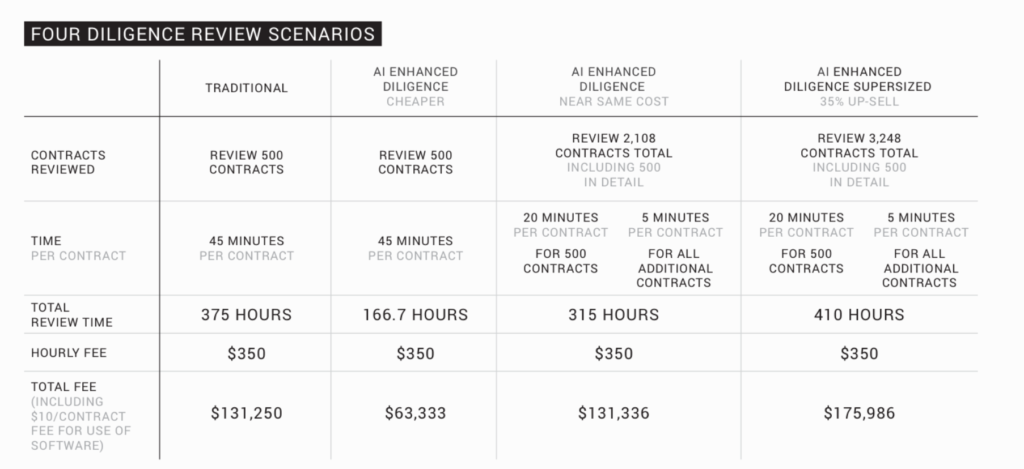
How do you calculate the ROI of legal tech tools that your firm or inhouse team have bought? Moreover, are there any universal metrics that can be used? Artificial Lawyer asked several founders across a range of companies what they thought. Here is what they said.
First, let’s do a NLP-driven bulk review tool. In this case, Kira Systems. CEO Noah Waisberg quoted from the company’s own recent book ‘AI for Lawyers’. The focus on ROI here addresses one of the fundamentals of legal tech: efficiency. But Waisberg also considers several other benefits.
‘A common response is to think of [using Kira] purely in terms of efficiency – that with AI you can do the same amount of work in less time, with the ROI coming in the form of lower costs for the same amount of work,’ he noted in the book.
And this approach makes the most sense when you have a fixed fee for that part of the work, e.g. the due diligence review. But, he continued: ‘Another way to think about ROI, however, is that AI allows users to do more work, not just to do the same amount of work more cheaply. …. [or you can also] think about the ROI of AI in contract review [in terms of] its impact on realisation rates.’
I.e. when using an NLP analysis solution – if the firm is set up already for its use – then a firm can get through the basic due diligence much faster, leaving them more time to focus on higher value input. In turn, the client values this more impactful additional input and is less likely to write off part of the bill. The hope is that firms not only keep the client happy, but they could actually make more money.

The book then goes on to give several possible examples (see above) of how all of this would work. But, it looks like each ROI outcome will be dependent upon on the specific scenario of the deal, e.g. is the client pushing for a very quick finish; is there a fixed fee element; how much do they value the extra input from associates; and also it needs to be said: has the law firm got set up to handle this kind of matter with the NLP tool already?
So, there are ways to show ROI, but each matter will come out a little differently depending on multiple factors.
Julia Salasky, CEO of Legl, the client experience platform, which is mostly focused on small- to medium-size law firms, works in a very different part of the market. Does she also see clear ROI metrics?

‘[If you look at] what Legl does in relation to business operations and client lifecycle management, there is clear ROI:
- time to value of a client,
- how many clients are repeat clients and what drives that behaviour,
- drop-off before instruction,
- present value of cash,
- team efficiency metrics (time spent fee earning vs on admin or non-billable hours),
- reduction of time in client transactions,
- and even client Net Promotor Score, are all ways to measure the value of technology spend.’
And Tim Pullan, CEO of NLP-driven ThoughtRiver, which helps clients to more rapidly analyse contracts for risk and find key data, is also confident on the ability to show ROI. He picked out three ways to demonstrate this:
- ‘Contracts signed per lawyer per month (all contracts in a business) – this is a measure of efficiency.
- Hours spent in Word reviewing contracts per lawyer per month as a % of total hours – this is a measure of quality of life and business impact ( we want lawyers out of MS Word and interacting with the business for greater impact).
- Ratio of monthly active legal users vs active business users as a percentage, with 20% or less being major success – this is a measure of how well legal is helping the business to self-serve.’
As you can see, different tools are producing different ROI metrics. But those metrics are there.
A Universal Approach?
So, there are objective metrics we can use. But are there universal metrics that apply across the sector? I.e. are the ways we measure the benefits of a bulk transactional review tool also relevant to how we measure the ROI benefits of a no-code decision automation system, for example?
Michael Grupp, CEO of BRYTER, had this to say: ‘Universal metrics we are seeing are:
- added revenue,
- saved costs,
- saved time/hours,
- faster deployment,
- and faster time to value.’
‘There is also some reduced risk that may be harder to measure,’ he added.
And those KPIs do seem applicable to many situations. However, Richard Mabey, CEO of contracting platform, Juro, saw things a bit differently.
‘It’s wrong to think that there are universal success metrics that can be applied to the legal tech software category [as a whole]. Success metrics should relate back to the specific business challenge that the customer sets out to solve. It shouldn’t be a generic approximation,’ he said.
I.e. avoid saying ‘legal tech tool X gives Y return on investment’, the way to do this is to look at the specific business need and then see if your input is helping there.
For example, Mabey added: ‘You can usually measure ROI. Why? Because legal tech exists to solve problems. If a provider solves those problems it delivers value. Value to businesses can usually (and should) be measured.
‘Here’s a simplified example:
- My team is bogged down in low-value contract work
- This means they can’t work on high-value contract work
- We buy a legal tech solution that automates contract tasks
- This reduces human time on the low-value contract work
- ROI = (fully loaded people costs saved + opportunity cost saved) / (software licenses costs * (1 + opportunity cost of capital))’
Salasky also stressed the need to focus on the client need as the way to approach ROI.
‘In terms of universal metrics, any business, including a law firm, will have levers of value that drive their business. There’s a strong case for prioritising which of those are the most important to a legal business, quantifying the change in value any lever can drive (e.g., if 10% fewer clients drop off at instruction stage; if 10% more clients can be serviced because transactions are quicker; if NPS increases by +1 what that means for referrals), and identifying whether technology products can drive that change more cheaply than people.’
So, again, it’s all about what the user of the tool wants most – and also again it is context specific.
Do We Have to Show ROI?
OK, so we can find ROI, even if it may be relative to specific client needs, but do we need it? Let’s face facts, not every legal tech company pitch begins with a clear setting out of specific ROI metrics. And perhaps not every buyer asks those kinds of questions either. Is ROI an essential area to focus on?
Grupp at BRYTER stressed that, yes, it is essential. He added that the lack of focus on ROI is in fact a major cause of problems in the legal tech world.

‘In every sales process ROI should be the core question. Of course, there may have been examples in the last few years where people bought technology just for the sake of having it, testing it, or out of sheer FOMO.
‘But today, for educated and savvy law firms and corporate departments, the only thing justifying an investment is measurable benefits. [In other sectors] most of our customers can give a clear before-after comparison, with clearly measurable differences and defined ROI,’ Grupp explained.
Conclusion
So, yes, you can show ROI, but in most cases it will be driven by what a specific client wants from an equally specific situation. The ROI comes from addressing that need – and for each client there may be a range of such needs. Moreover, those needs might change depending on the situation.
This all makes a universal metrics approach quite hard to achieve, although, as Grupp noted, there are some broad categories of improvement that should be applicable, at least in some cases. Though perhaps to make them really useful you will still need to drill down to a specific client need.
What perhaps is most noticeable – and something this site sees a lot of, on both the buy and sell side of legal tech, is how rarely detailed debates about ROI come up. Perhaps this is something to do with the legal sector, which often tends to shy away from such calculations when it comes to legal work?
In any case, it looks like plenty of legal tech companies are in fact comfortable talking about ROI and have developed metrics to help the buyers make an informed choice. This is good to see as it all helps to make legal tech a sector that can prove its worth and stand upon clear, factual data.

3 Trackbacks / Pingbacks
Comments are closed.